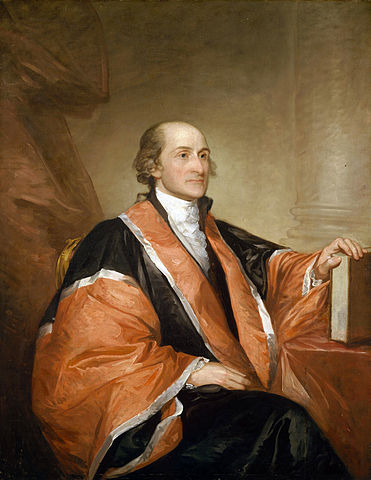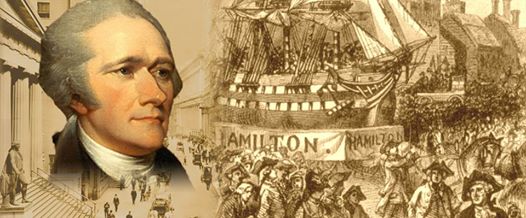This Week in History
April 12-18, 2015
John Jay Fights for New York
to Ratify the Constitution
April 1788
By Nancy Spannaus
 John Jay (1745-1829), portrait by Gilbert Stuart (1755-1828). |
Among the leading collaborators with Alexander Hamilton, in the securing of the United States and its Constitution, was the prominent New Yorker John Jay (1745-1829). Jay's participation in the Revolution and the establishment of the republic spanned from the first Continental Congress through his roles as ambassador and de facto Secretary of State under the Confederation, to Chief Justice and Governor of New York--and was honorable from start to finish. He was a champion against slavery, an indomitable fighter for national sovereignty, and a strong supporter of Hamilton's American System.
In ths remembrance, we single out his role in the battle to get New York to ratify the Federal Constitution, a battle that was exceedingly intense in April of 1788.
It was in the April 12-15 timeframe, approximately two weeks before the scheduled election of delegates to the June ratifying convention in Poughkeepsie, that Jay published a 19 page pamphlet, entitled "An Address to the People of the State of New York." Jay signed his pamphlet "A Citizen of New York," but there was little doubt in anyone's mind as to who the author was. Jay's argument took on the "seeds of discord and danger" that had been disseminated through the increasingly heated opposition to the Constitution, and laid out in some detail the devastation which the lack of an active national government had brought upon the nation. The Constitution, with all its obvious compromises, was essential in order to restore the path to the "general welfare and common good."
Like Hamilton, Franklin, and Washington, Jay took considerable note of the strategic implications of whether the United States succeeded in establishing a firm Union, referencing those foreign nations who "behold our rapid population with regret, and apprehend that the enterprising spirit of our people, when seconded by power and probability of success, may be directed to objects not consistent with their policy or interests," and "cannot fail to wish that we may continue to be a weak and divided people." He was thinking of the country as a whole, and its future--not just about New York.
Particularly poignant was his conclusion:
"Consider then, how weighty and how many considerations advise and persuade the people of America to remain in the safe and easy path of Union: to continue to move and act as they hitherto have done, as a band of brothers; to have confidence in themselves and in one another; and since all cannot see with the same eyes, at least to give the proposed Constitution a fair trial, and to mend it as time, occasion, and experience may dictate. It would little become us to verify the predictions of those who ventured to prophecy that peace, instead of blessing us with happiness and tranquility, would serve only as the signal for factions, discords and civil contentions to rage in our land, and overwhelm it with misery and distress.
"Let us also be mindful that the cause of freedom greatly depends on the use we make of the singular opportunities we enjoy of governing ourselves wisely; for if the event should prove, that the people of this country either cannot or will not govern themselves, who will hereafter be advocates for systems, which however charming in theory and prospect, are not reducible to practice. If the people of our nation, instead of consenting to be governed by laws of their own making, and rulers of their own choosing, should let licentiousness, disorder, and confusion reign over them, the minds of men every where, will insensibly become alienated from republican forms, and prepared to prefer and acquiesce in Governments, which, though less friendly to liberty, afford more peace and security.
"Receive this Address with the same candor with which it is written; and may the spirit of wisdom and patriotism direct and distinguish your councils and your conduct."
Jay's arguments may well have played a role in the outcome of the election of delegates to the Convention in New York City, where he was on the list. He ended up with the highest vote total of any of the Federalists, including Hamilton. However, neither his pamphlet, nor the Federalist Papers, which had been circulating in newspapers in New York State since October of 1787, succeeded in preventing the opponents of the Constitution, led by Governor George Clinton, from sweeping the election, 46 to 19. In New York City, of course, the Federalists made a clean sweep.
But Jay--like his collaborators Hamilton and Washington--were determined to succeed. His pamphlet continued to circulate, and he strategized with the others, including by putting into circulation the rumor that New York City might have to secede from the state to join the Union, should the anti-Constitution majority prevail. At the Poughkeepsie Convention, which convened on June 17, Jay took an active part in speaking and organizing, and, thanks in no small part to the decisions by Virginia and New Hampshire to ratify while the New York Convention was ongoing, helped steer the convention to success. On July 23 over 5000 New York City residents celebrated the passing of the threshhold for the Constitution going into effect by 9 states or more, by staging a Grand Federal Procession behind the "Federal Ship Hamilton." The celebration, which featured people from all walks of life, especially tradesmen, was capped by a banquet where the toast rang out: May they soon add an eleventh pillar to the Federal Edifice."

Bob Wesser
Left: Alexander Hamilton. Right: After New York ratified the Constitution in 1788, New York City celebrated with a parade. Hamilton, the Constitution's champion, was honored by a float representing the federal ship Hamilton. |
Jay, Hamilton, Isaac Roosevelt, and the other nationalists at the Poughkeepsie convention succeeded in winning the vote for the Constitution three days later, on July 26, by 30 to 27.
Jay's full pamphlet can be read at http://teachingamericanhistory.org/library/document/a-citizen-of-new-york/
